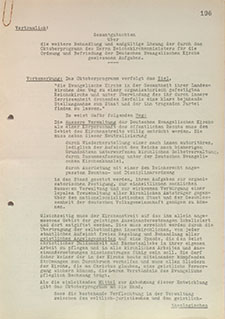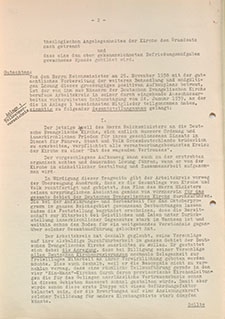The Reich Minister's October Program
In the fall of 1938, Reich Minister of Church Affairs Hanns Kerrl once again drew up an ecclesio-political program in order to end the incessant political unrest and conflicts in the Protestant church. He intended his “October Program” to provide proof of the Protestant church’s right to exist in the Nazi state before Hitler and the anti-church forces in the state and party.
Kerrl’s program envisioned the separation of secular legal church administration and sacred religious affairs. Administration was supposed to be centralized and placed under state supervision, while religious affairs were supposed to be left to a synod consisting of all of the ecclesio-political factions.
Kerrl hoped to be able to push through his program on the basis of a broad church center with abundant involvement of church laity. He was under the influence of notable representatives of a “völkisch” theology of the center, who not only wanted to adhere to the Gospel and the Book of Concord but also viewed a synthesis of Christianity and National Socialism as the order of the day.
Completely misjudging the Nazi state’s real ecclesio-political intentions, this circle announced in Circular No. 3 of the “People’s Church Council” of December 14, 1938: Whatever temporal orders the people of God need as ‘church’ should be governed by the state. Whatever is ‘sacred’, however, does not concern secular authority.
The church center’s exponents’ conviction that the church could be reorganized in cooperation with the Reich Minister of Church Affairs, which had been politically sidelined since 1937, was illusory. Hitler had long since lost interest in the Protestant church and shelved decisions on the issue of the church.
Kerrl’s foes within the party planned a radical separation of church and state. They regarded Kerrl’s plan as an undesirable increase of the power vested in the church. The notorious “Reich Main Security Office”, which had been newly established by Heinrich Himmler in 1939 and merged the Gestapo, Security Service and the police, criticized that the October Program was leading to the creation of a state church. Himmler intervened personally and torpedoed Kerrl’s program.
The Reich Minister of Church Affairs also failed to obtain the expected majority of clergy and laity from the church center for his plan. Not only the Confessing Church but also church leaders who were not German Christians rejected Kerrl’s program because they regarded the separation of secular and religious affairs as contrary to the Confessions and feared a repetition of the policy of forcible integration in the Reich Church pursued by Reich Bishop Müller in 1934.
When the representatives of the center authorized by Kerrl submitted their comprehensive “Complete Report on Bringing Order and Peace to the German Evangelical Church” in January of 1939, the October Program had already failed politically and ecclesiastically.
Source / title
- ©Evangelisches Zentralarchiv in Berlin, 1/1270, Bl. 196


